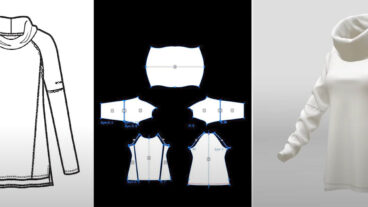When I shop for clothing, I’m more focused on how the garment looks than where it was made, what it’s made of, and what I’ll do with it when it’s worn out.
After chatting with Revital Nadiv, I realize I’m going to have to get more environmentally mindful about what I choose to wear.
Nadiv is cofounder of Re-Fresh Global, an Israeli eco-business offering awareness activities and consulting in the field of sustainable fashion innovation.
Clothing is a notoriously unsustainable industry. Consider these facts:
– It takes 1,320 liters of water to produce one pair of jeans.
– The average American throws away 80 pounds of clothes every year.
– 13 million tons of unsold items get thrown away or burned by clothing retailers each year.
– About 60% of materials used in the fashion industry are made from plastic.
– The fashion industry is responsible for 8-10% of carbon emissions, more than all international flights and maritime shipping combined.
Re-Fresh Global invented a biotech process to upcycle textile waste as raw manufacturing materials. This brilliant project began in Israel and is currently based in Berlin.

Realistically speaking, most of us won’t become sustainable fashion superstars. But these tips from Nadiv can help us develop greener wardrobe decision-making skills.
1. Read the fine print
Several big retailers, such as H&M and Mango, are using recycled textiles in their garments.
But to avoid being fooled by greenwashing, read the label carefully to see if the percentage of recycled material is significant enough to make you choose this item over another.
2. Check for a certification label
Several organizations certify fashion companies based on parameters including sustainability and how they impact the environment. Examples are B Lab, Cradle to Cradle Certified, and OECO-TEX.
3. Consider quality
To extend the wearable life of an item, opt for quality materials.
“For example, Eileen Fisher uses mainly wool, which can be worn a long time and can be endlessly recycled,” says Nadiv. This brand also has taken back more than 1.5 million pieces of clothing to resell, donate or repurpose into new items since 2009.
4. Choose design for disassembly
Any article of clothing with multiple buttons, metal studs or zippers will end up in landfill because it’s hard to recycle anything with all those accessories attached.
5. Natural is better
In general, the more natural the material, the less impact it has on the environment because it’s less toxic and easier to recycle.
This topic is complicated, however. For instance, growing cotton conventionally uses lots of water and pesticides, degrades soil and releases greenhouse gases. Sustainably grown organic cotton is a greener choice.
6. Buy local
Patronize local designers and manufacturers. They can be transparent about the value chain of the product, starting with where it was sewn and under what conditions. Plus, the garment has a lower carbon footprint since it didn’t get shipped from far away.
7. Rent rather than buy
If you need an expensive dress or suit for a special occasion, go to an online clothing rental platform (like this or this) instead of a retail store.
Another alternative: “Some stores let you purchase a garment for a night, bring it back the next day and get 85% of your money refunded,” says Nadiv.
8. Shop secondhand, thrift and vintage
Before buying something new for yourself or your child, see if you can find a like-new version of what you’re seeking.
In addition to bricks-and-mortar thrift shops, you can join local Telegram and WhatsApp groups devoted to selling secondhand items or download a secondhand clothing app where you receive tokens to use for in-app purchases.
You’ll save money and the gently used garment will be saved from landfill or incineration.
9. Host a swap
When you’re tired of a piece of clothing or an accessory, or it doesn’t fit anymore, swap it instead of tossing it.
Host a physical clothing-swap party for your friends or download a local clothing-swap app where members create digital closets for others in the area to peruse.
10. Repurpose your old uniform
Many people wear uniforms to work. After the uniforms are worn out, there are few options other than discarding them. Nadiv suggests finding a company that accepts uniforms for textile recycling.
“There are more than 20 startups in the world today, including ours, that are repurposing textiles,” she says.
11. If you can’t sell or donate it, repurpose it
Some used items can be donated to charities. Others, such as socks and underwear, or articles of clothing in poor condition, will not be accepted by charities and will end up buried or burned.
Whenever possible, repurpose them. Use your hole-y socks as cleaning cloths. Give pieces of an old dress new life in a crafts project such as a patchwork quilt or rag doll. Cut out the stained areas of a shirt and repurpose the rest as a scarf or tie.
















